Root Exploration, Initial Moisture Conditions, and Irrigation Scheduling Influence Hydration of Stratified and Non-Stratified Substrates †
Abstract
:1. Introduction
2. Materials and Methods
2.1. Substrate Preparation
2.2. Physical Properties
2.3. Treatment Preparation
2.4. Experimental Category and Initial Conditions
2.4.1. Experiment 1: Effective Container Capacity
2.4.2. Experiment 2: Flagging Initial Moisture Conditions; (20% VWC)
2.4.3. Experiment 3, Dry Initial Moisture Conditions; (10% VWC)
2.5. Irrigation Volume Determination
2.6. Applying Irrigation
2.6.1. Experiment 1
2.6.2. Experiments 2 and 3
2.7. Mass Balance
2.8. Data Analysis
3. Results
3.1. Static Physical Properties
3.2. Experiment 1, eCC Initial Moisture Conditions
3.3. Experiment 2, Flagging Initial Moisture Conditions; (20% VWC)
3.3.1. Single Application
3.3.2. Cyclic Application
3.4. Experiment 3, Dry Initial Moisture Conditions; (10% VWC)
3.4.1. Single Application
3.4.2. Cyclic Application
4. Discussion
4.1. Non-Stratified versus Stratified
4.2. Single Application versus Cyclic Application
4.3. Fallow versus Rooted
4.4. Initial Moisture Conditions
5. Conclusions
Author Contributions
Funding
Institutional Review Board Statement
Informed Consent Statement
Data Availability Statement
Acknowledgments
Conflicts of Interest
References
- Elliot, J.; Deryng, D.; Müller, C.; Frieler, K.; Konzmann, M.; Gerten, D.; Glotter, M.; Flörke, M.; Wada, Y.; Best, N.; et al. Constraints and potentials of future irrigation water availability on agricultural production under climate change. Proc. Nat. Acad. Sci. USA 2014, 111, 3239–3244. [Google Scholar] [CrossRef] [PubMed]
- Whitehead, P.G.; Wilby, R.L.; Battarbee, R.W.; Kernan, M.; Wade, A.J. A review of the potential impacts of climate change on surface water quality. Hydrol. Sci. J. 2009, 54, 101–123. [Google Scholar] [CrossRef]
- Lal, R.; Delgado, J.A.; Gulliford, J.; Nielsen, D.; Rice, C.W.; Van Pelt, R.S. Adapting agriculture to drought and extreme events. J. Soil Water Conserv. 2012, 67, 162A–166A. [Google Scholar] [CrossRef]
- Liu, W.; Sun, F.; Lim, W.H.; Zhang, J.; Wang, H.; Shiogama, H.; Zhang, Y. Global drought and severe drought-affected populations in 1.5 and 2 °C warmer worlds. Earth Syst. Dynam. 2018, 9, 267–283. [Google Scholar] [CrossRef]
- Fulcher, A.; Fernandez, T. Sustainable Nursery Irrigation Management Series: Part I. Water Use in Nursery Production; Bulletin W287; University of Tennessee: Knoxville, TN, USA, 2013. [Google Scholar]
- Fields, J.S.; Owen, J.S., Jr.; Altland, J.E. Substrate stratification: Layering unique substrates within a container increases resource efficiency without impacting growth of shrub rose. Agron. J. 2021, 11, 1454. [Google Scholar] [CrossRef]
- Milks, R.R.; Fonteno, W.C.; Larson, R.A. Hydrology of horticultural substrates: II. Predicting physical properties of substrate in containers. J. Amer. Soc. Hort. Sci. 1989, 114, 53–56. [Google Scholar] [CrossRef]
- Owen, J.S.; Altland, J.E. Container height and Douglas fir bark texture affect substrate physical properties. Hort. Sci. 2008, 43, 505–508. [Google Scholar] [CrossRef]
- Criscione, K.S.; Fields, J.S.; Owen, J.S., Jr.; Fultz, L.; Bush, E. Evaluating Stratified Substrates Effect on Containerized Crop Growth under Varied Irrigation Strategies. Hort. Sci. 2022, 57, 400–413. [Google Scholar] [CrossRef]
- Fields, J.S.; Criscione, K.S.; Edwards, A. Single-screen bark particle separation can be utilized to engineer stratified substrate systems. Hort. Tech. 2022, 32, 7. [Google Scholar] [CrossRef]
- Khamare, Y.; Marble, S.C.; Altland, J.E.; Pearson, B.J.; Chen, J.; Devkota, P. Effect of substrate stratification on growth of common nursery weed species and container-grown ornamental species. Hort. Tech. 2022, 32, 74–83. [Google Scholar] [CrossRef]
- Criscione, K.S.; Fields, J.S.; Owen, J.S. Exploring Water Movement through Stratified Substrates. Comb. Proc. IPPS 2021, 71, 116–124. [Google Scholar]
- Lamack, W.F.; Niemiera, A.X. Application method affects water application efficiency of spray stake-irrigated containers. Hort. Sci. 1993, 28, 625–627. [Google Scholar] [CrossRef]
- Fare, D.C.; Gilliam, C.H.; Keever, G.J.; Olive, J.W. Cyclic irrigation reduces container leachate nitrate-nitrogen concentration. Hort. Sci. 1994, 29, 1514–1517. [Google Scholar] [CrossRef]
- Taylor, A.J.; Fernandez, R.; Nzokou, P.; Cregg, B. Carbon Isotope Discrimination, Gas Exchange, and Growth of Container-grown Conifers Under Cyclic Irrigation. Hort. Sci. 2013, 48, 848–854. [Google Scholar] [CrossRef]
- Raviv, M.; Leith, J.H. Soilless Culture Theory and Practice; Elsevier: San Diego, CA, USA, 2008. [Google Scholar]
- Drzal, M.S.; Fonteno, W.C.; Cassel, D.K. Pore fraction analysis: A new tool for substrate testing. Acta Hort. 1999, 481, 43–54. [Google Scholar] [CrossRef]
- Airhart, D.L.; Natarella, N.J.; Pokorny, F.A. Influence of initial moisture content on the wettability of a milled pine bark medium. Hort. Sci. 1978, 13, 432–434. [Google Scholar]
- Valat, B.; Jouany, C.; Riviere, L.M. Characterization of the wetting properties of air dried peats and composts. Soil Sci. 1991, 152, 100–107. [Google Scholar] [CrossRef]
- Michel, J.C.; Riviere, M.; Bellon-Fontaine, M.N. Measurement of wettability of organic materials in relation to water content by the capillary rise method. Eur. J. Soil. Sci. 2001, 52, 459–467. [Google Scholar] [CrossRef]
- Fields, J.S.; Fonteno, W.C.; Jackson, B.E. Hydrophysical properties, moisture retention, and drainage profiles of wood and traditional components for greenhouse substrates. Hort. Sci. 2014, 49, 336–342. [Google Scholar] [CrossRef]
- Hoskins, T.C.; Owen, J.S.; Fields, J.S.; Altland, J.E.; Easton, Z.M.; Niemiera, A.X. Solute Transport through a Pine Bark-based Substrate under Saturated and Unsaturated Conditions. J. Amer. Soc. Hort. Sci. 2014, 139, 634–641. [Google Scholar] [CrossRef]
- Beeson, R.C. Weighing lysimeter systems for quantifying water use and studies of controlled water stress for crops grown in low bulk density substrates. Agri. Water Manag. 2011, 98, 967–976. [Google Scholar] [CrossRef]
- Fields, J.S.; Owen, J.S., Jr.; Altland, J.; van Iersel, M.; Jackson, B.E. Soilless substrate hydrology can be engineered to influence plant water status for an ornamental containerized crop grown within optimal water potentials. J. Amer. Soc. Hort. Sci. 2018, 143, 268–281. [Google Scholar] [CrossRef] [Green Version]
- McCauley, D.; Levin, A.; Nackley, L. Reviewing Mini-lysimeter Controlled Irrigation in Container Crop Systems. Hort. Tech. 2021, 31, 634–641. [Google Scholar] [CrossRef]
- Prehn, A.E.; Owen, J.S.; Warren, S.L.; Bilderback, T.E.; Albano, J.P. Comparison of water management in container-grown nursery crops using leaching fraction or weight-based on demand irrigation control. J. Environ. Hort. 2010, 28, 117–123. [Google Scholar] [CrossRef]
- O’Meara, L.; van Iersel, M.W.; Chappell, M.R. Modeling daily water use of Hydrangea macrophylla and Gardenia jasminoides as affected by environmental conditions. Hort. Sci. 2013, 48, 1040–1046. [Google Scholar] [CrossRef]
- Niu, G.; Rodrigues, D.S.; Cabrera, R.; McKenney, C.; Mackay, W. Determining water use and crop coefficients of five woody landscape plants. J. Environ. Hort. 2006, 24, 160–165. [Google Scholar] [CrossRef]
- Fonteno, W.C.; Harden, C.T. North Carolina State University Horticultural Substrates Lab Manual; North Carolina State University: Raleigh, NC, USA, 2010. [Google Scholar]
- Hoskins, T.C.; Owen, J.S.; Niemiera, A.X. Water movement through a pine-bark substrate during irrigation. Hort. Sci. 2014, 49, 1432–1436. [Google Scholar] [CrossRef]
- Ma, L.N.; Selim, H.M. Physical nonequilibrium modeling approaches to solute transport in soils. Adv. Agron. 1997, 58, 95–150. [Google Scholar]
- Hillel, D. Introduction to Environmental Soil Physics; Elsevier Academic Press: San Deigo, CA, USA, 2004. [Google Scholar]
- Nkongolo, N.V.; Caron, J. Bark particle sizes and the modification of the physical properties of peat substrates. Can. J. Soil Sci. 1999, 79, 111–116. [Google Scholar] [CrossRef]
- Selker, J.S. Applying preferential flow concepts to horticultural water management. Hort. Tech. 1996, 6, 107–110. [Google Scholar] [CrossRef]
- Zhang, S.; Yan, H.; Teng, J.; Sheng, D. A mathematical model of tortuosity in soil considering particle arrangement. Vadose Zone 2020, 19, e20004. [Google Scholar] [CrossRef]
- Bilderback, T.E.; Jones, R.K. Horticultural practices for reducing disease development. In Disease of Woody Ornamentals and Trees in Nurseries; Jones, R.K., Benson, D.M., Eds.; American Phytopathological Society (APS Press): St Paul, MN, USA, 2001; pp. 387–400. [Google Scholar]
- Witcher, A.L. Evaluation of Fertilizer and Irrigation Production Systems for Large Nursery Containers. Masters Thesis, Louisiana State University, Baton Rouge, LA, USA, 2003. [Google Scholar]
- Yeary, W.; Fulcher, A.; Leib, B. Nursery Irrigation: A Guide for Reducing Risk and Improving Production; University of Tennessee Extension: Knoxville, TN, USA, 2016. [Google Scholar]
- Warsaw, A.L.; Fernandez, R.; Cregg, B.M.; Andresen, J.A. Water Conservation, Growth, and Water Use Efficiency of Container-grown Woody Ornamentals Irrigated Based on Daily Water Use. Hort. Sci. 2009, 44, 1308–1318. [Google Scholar] [CrossRef]
- Liu, Y.P.; Steenhuis, T.S.; Parlange, J.Y. Formation and persistence of fingered flow-fields in coarse-grained soils under different moisture contents. J. Hydrol. 1994, 159, 187–195. [Google Scholar] [CrossRef]
- Bauters, T.W.J.; DiCarlo, D.A.; Steenhuis, T.S.; Parlange, J.Y. Soil water content dependent wetting front characteristics in sands. J. Hydrol. Amst. 2000, 231, 244–254. [Google Scholar] [CrossRef]
- Altland, J.E.; Owen, J.S.; Gabriel, M.Z. Influence of pumice and plant roots on substrate physical properties over time. Hort. Tech. 2011, 21, 554–557. [Google Scholar] [CrossRef]
- Nash, V.E.; Laiche, A.J. Changes in the characteristics of potting media with time. Commun. Soil Sci. Plant Anal. 1981, 12, 1011–1020. [Google Scholar] [CrossRef]
- de Jonge, L.W.; Jacobsen, O.H.; Moldrup, P. Soil water repellency: Effects of water content, temperature, and particle size. Soil Sci. Soc. Amer. J. 1999, 63, 437–442. [Google Scholar] [CrossRef]
- Yap, T.C.; Jackson, B.E.; Fonteno, W.E. Water retention of processed pine wood and pine bark and their particle size fractions. Comb. Proc. Intl. Plant Prop. 2014, 64, 467–472. [Google Scholar] [CrossRef]
- Blok, C.; De Kreij, C.; Baas, R.; Wever, G. Analytical Methods Used in Soilless Cultivation, Chapter 7. In Soilless Culture Theory and Practice; Elsevier: San Diego, CA, USA, 2008. [Google Scholar]
- King, P.M. Comparison of methods for measuring severity of water repellence of sandy soils and assessment of some factors that affect its measurement. Aust. J. Soil. Res. 1981, 19, 275–285. [Google Scholar] [CrossRef]
- Dekker, L.W.; Ritsema, C.J. How water moves in a water repellant sandy soil: 1. Potential and actual water repellency. Water Resour. Res. 1994, 30, 2507–2517. [Google Scholar] [CrossRef]
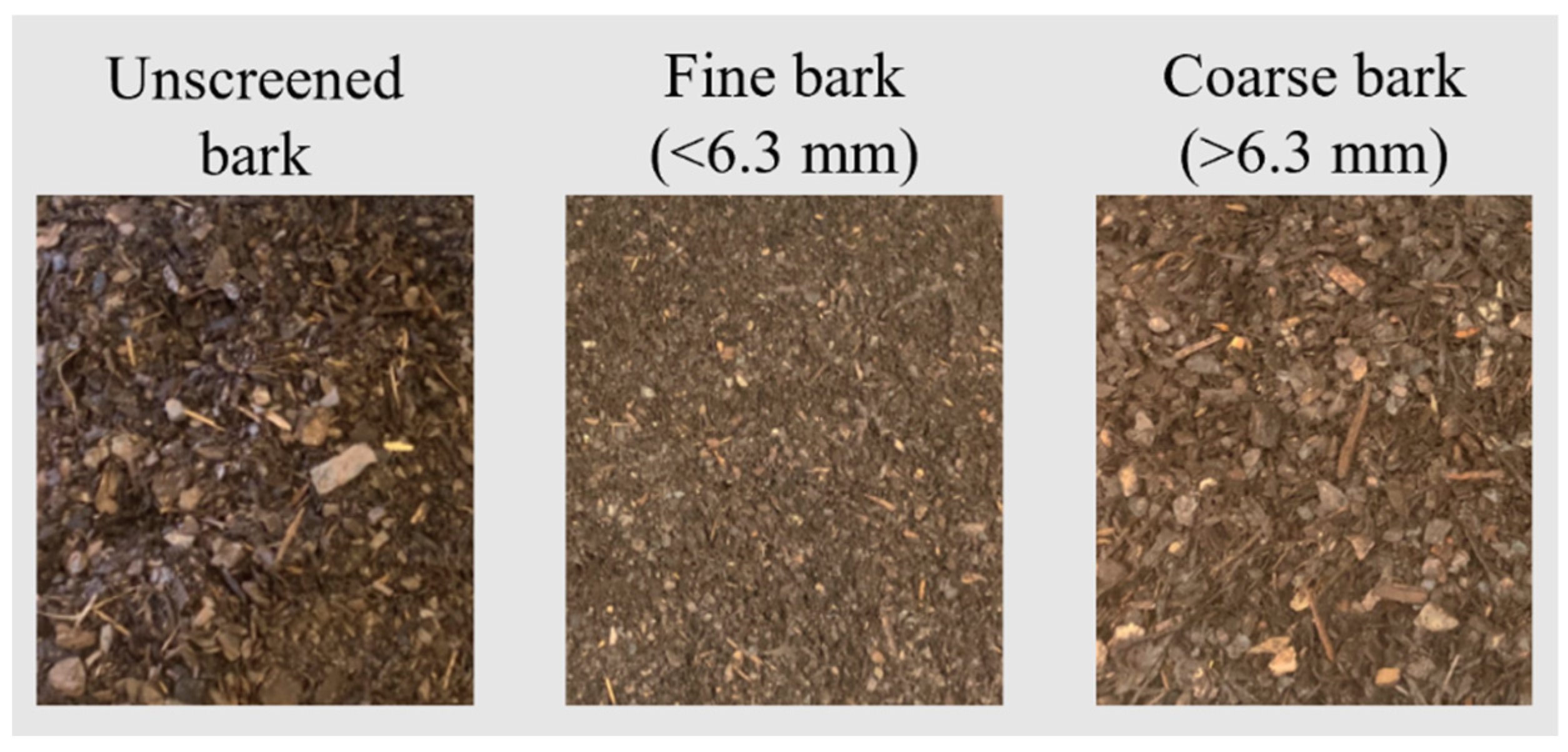

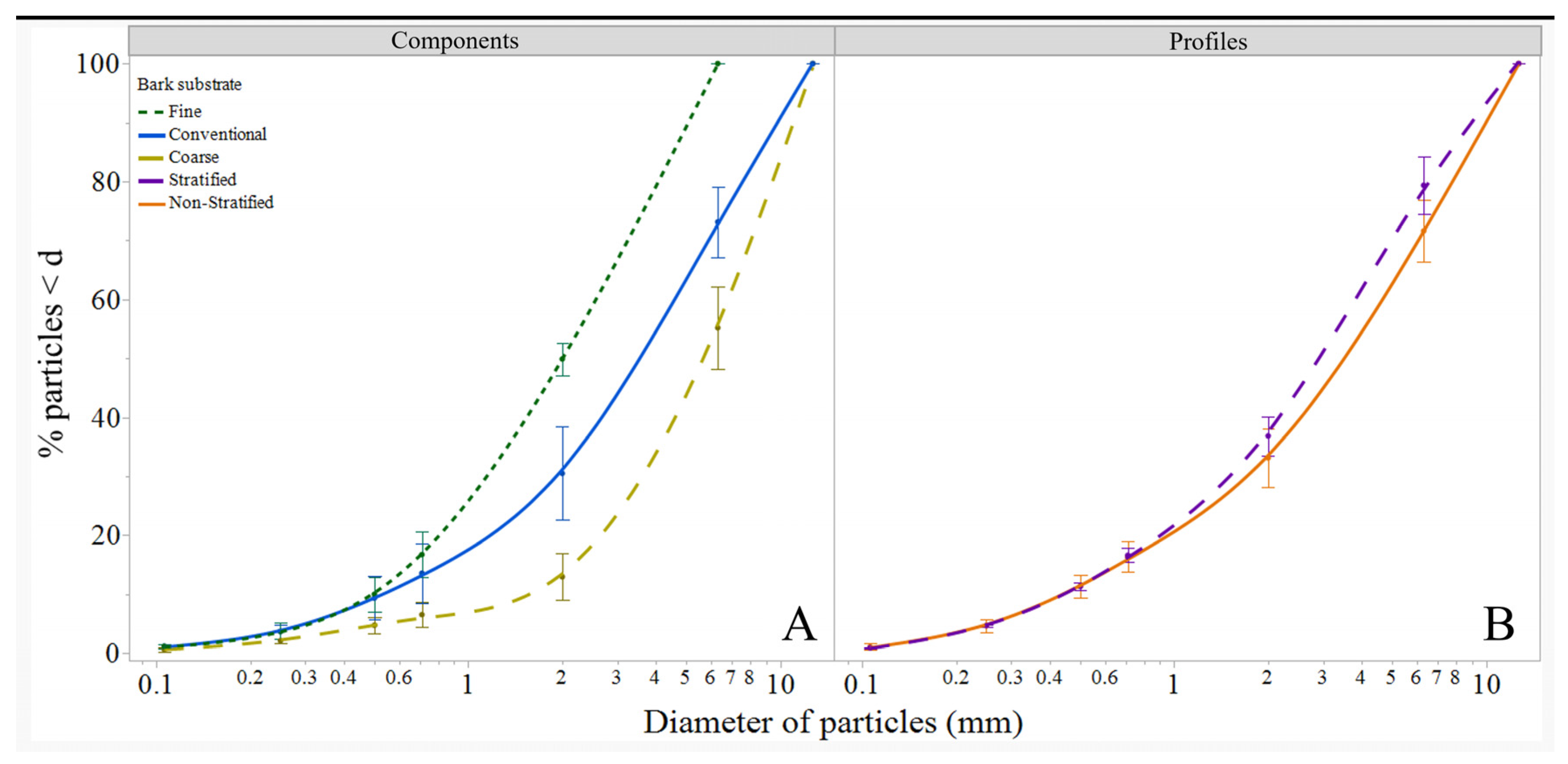
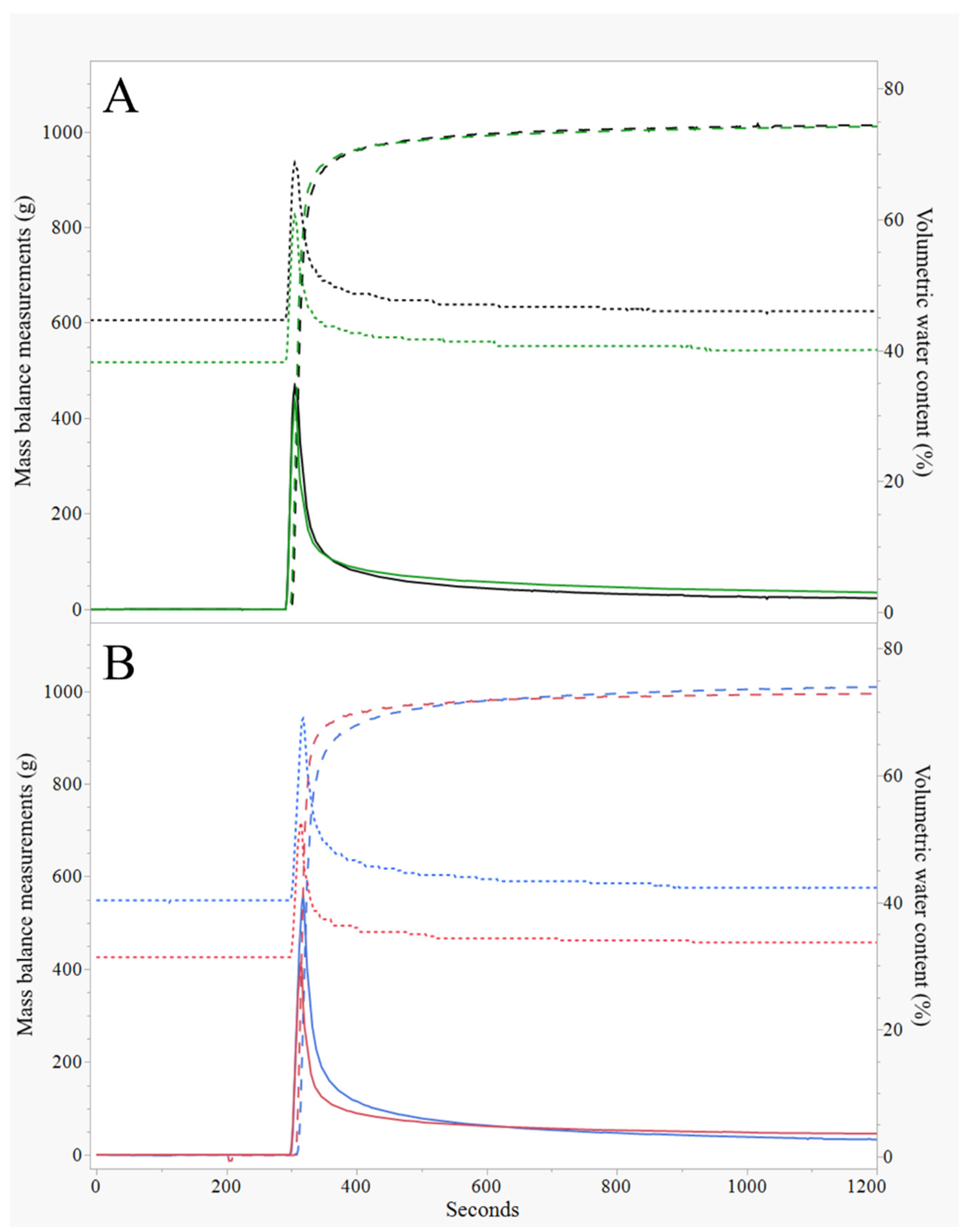
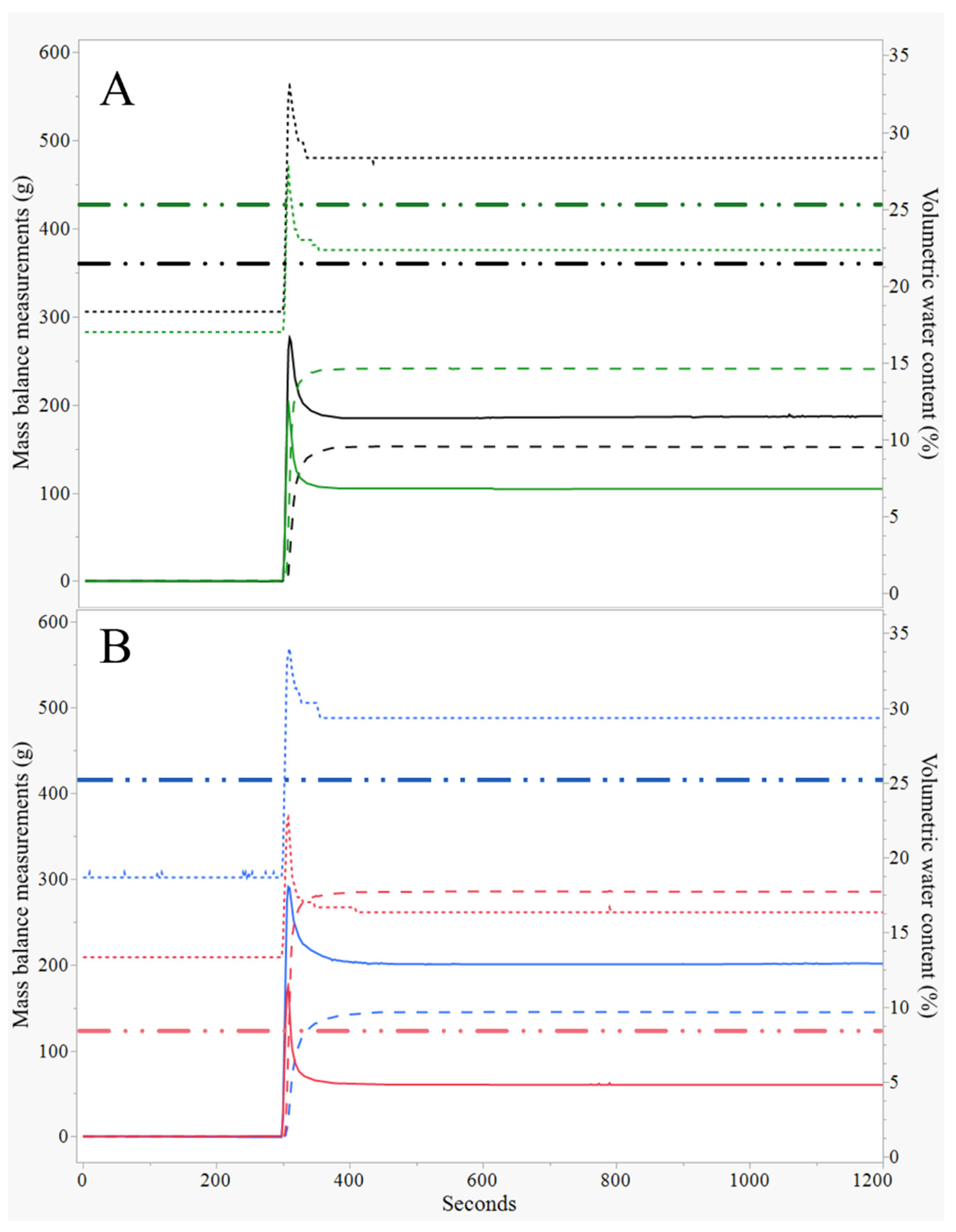

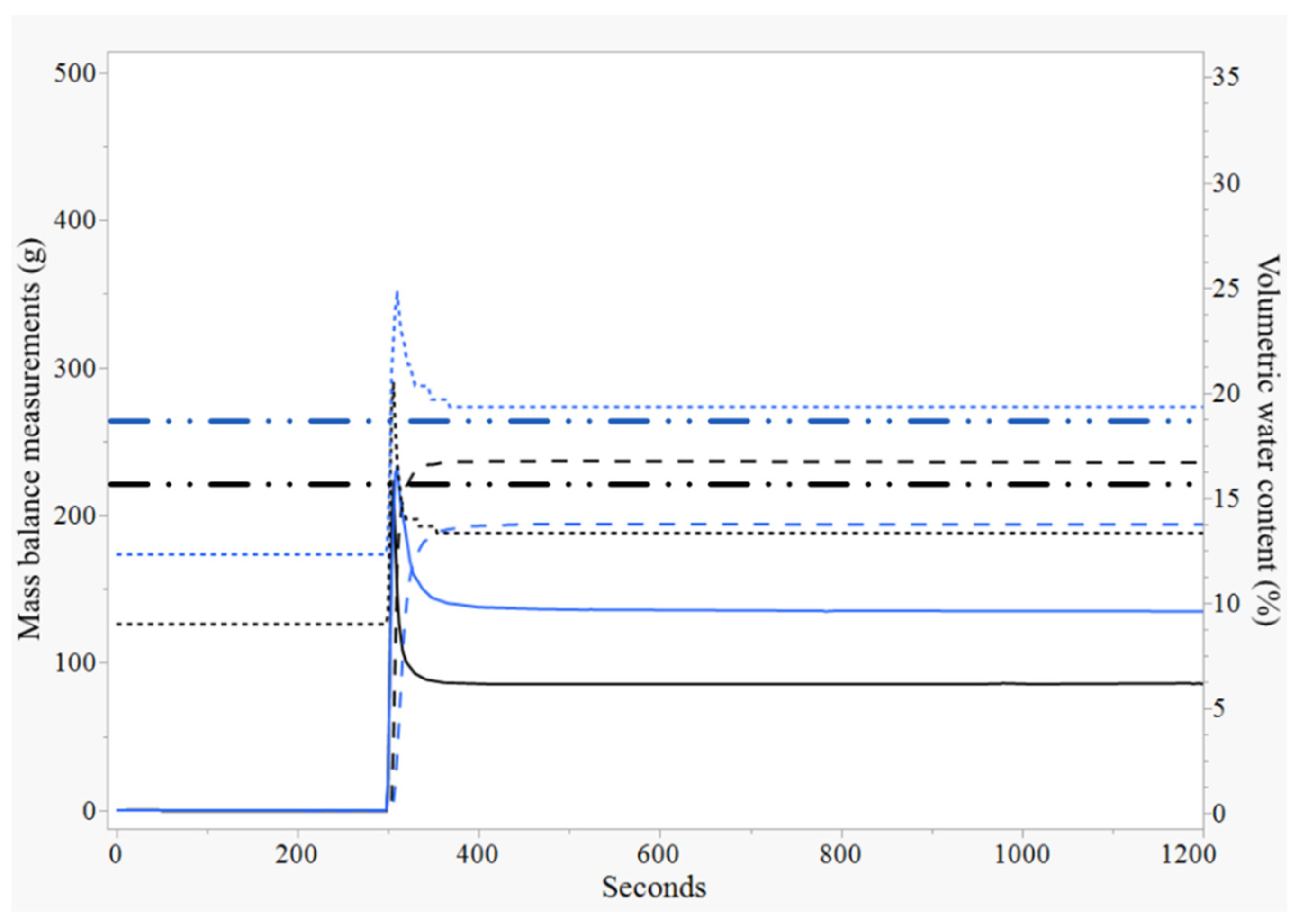
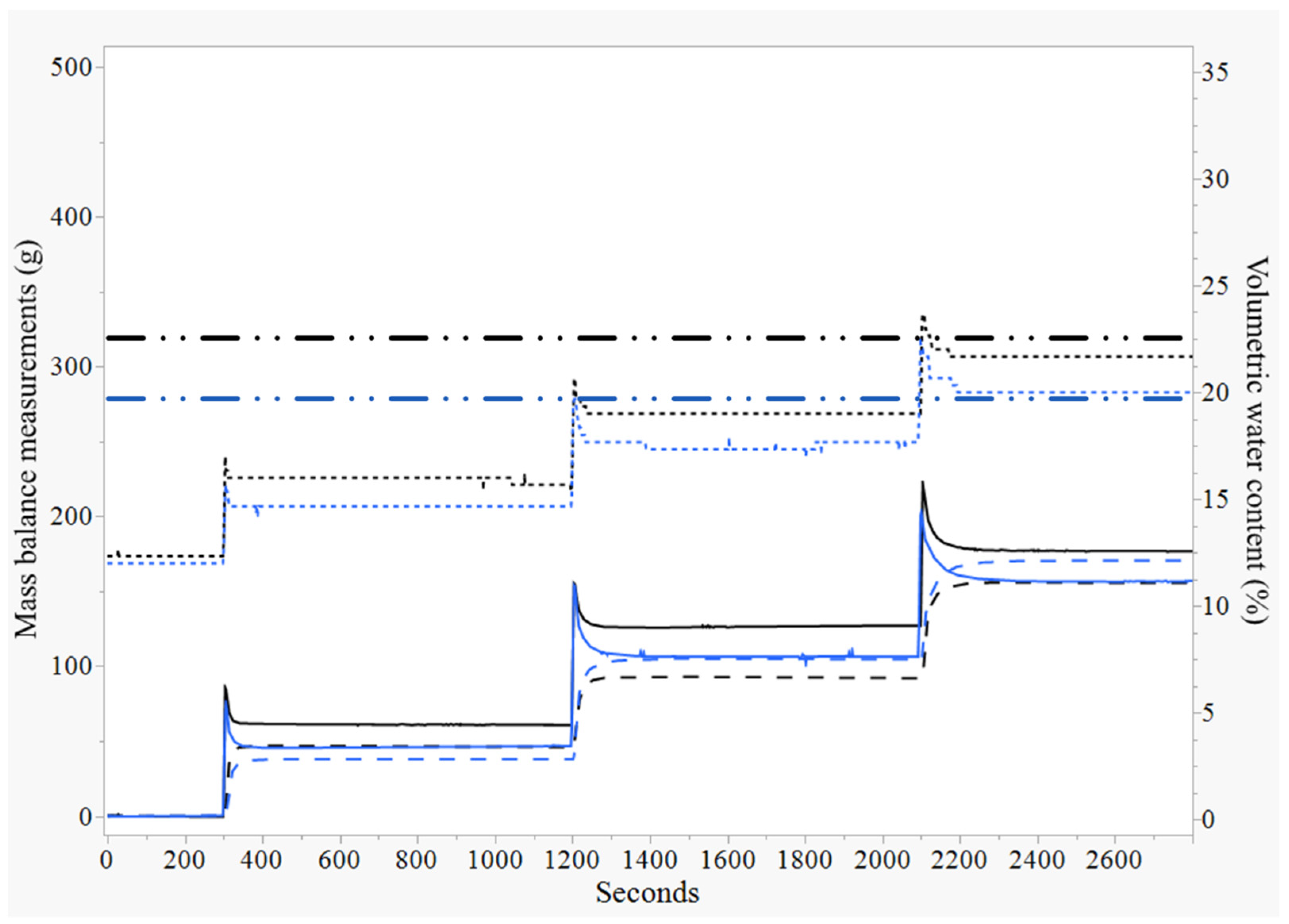
| Static Physical Properties z | Particle Size Distribution y | |||||||
|---|---|---|---|---|---|---|---|---|
| Substrate | Container Capacity (% vol.) | Air Space (% vol.) | Total Porosity (% vol.) | Bulk Density (% vol.) | Extra Large (>6.3 mm; % Dry Mass) | Large (6.3 mm–2.0 mm; % Dry Mass) | Medium (2.0-0.7 mm; % Dry Mass) | Fine (<0.7 mm; % Dry Mass) |
| Conventional bark | 43 b a | 35 b | 77 b | 17 a | 27 b | 43 b | 17 b | 14 a |
| Fine bark | 50 a | 33 b | 83 ab | 17 a | 0 c | 50 a | 33 a | 17 a |
| Coarse bark | 38 b | 47 a | 85 a | 15 b | 45 a | 42 b | 6 c | 7 b |
| p-value b | 0.0023 | 0.0041 | 0.0320 | 0.0037 | <0.0001 | <0.0001 | <0.0001 | <0.0001 |
| Initial Moisture Status z | Substrate | Container System y | Irrigation x | Irrigation Pulses (CA Only) w | Initial VWC (%) v | Retention Capacity (%) u | Effective Container Capacity (%) t | Difference in Actual CC to eCC (mL) s | Difference in Time from Water Entry to Exit (sec) r |
|---|---|---|---|---|---|---|---|---|---|
| eCC | Non-Stratified | Fallow | SA | NA | 44.6% ± 1.2 a ab | 45.8% ± 1.2 a | 45.8% ± 1.2 a | - | 8.0 ± 0.0 b |
| eCC | Non-Stratified | Rooted | SA | NA | 39.3% ± 1.2 b | 41.1% ± 0.9 b | 41.1% ± 0.9 b | - | 6.0 ± 0.0 b |
| eCC | Stratified | Fallow | SA | NA | 40.5% ± 2.6 ab | 42.2% ± 2.6 ab | 42.2% ± 2.6 ab | - | 10.7 ± 1.2 a |
| eCC | Stratified | Rooted | SA | NA | 32.4% ± 1.4 c | 34.8% ± 1.7 c | 34.8% ± 1.7 c | - | 7.3 ± 1.6 b |
| p-value c | - | - | - | - | 0.0002 | 0.0003 | 0.0003 | - | 0.0007 |
| Flag | Non-Stratified | Fallow | SA | NA | 18.6% ± 0.5 ab | 28.2% ± 3.4 abc | 40.5% ± 1.3 a | 239.3 ± 42.6 c | 7.3 ± 2.3 bc |
| Flag | Non-Stratified | Rooted | SA | NA | 18.9% ± 1.6 ab | 23.1% ± 3.8 bcde | 30.8% ± 4.3 b | 148.8 ± 11.4 def | 4.0 ± 2.0 c |
| Flag | Stratified | Fallow | SA | NA | 17.9% ± 0.5 ab | 29.3% ± 0.5 a | 39.7% ± 1.9 a | 202.0 ± 29.6 cd | 4.7 ± 2.3 c |
| Flag | Stratified | Rooted | SA | NA | 13.8% ± 0.1 d | 16.9% ± 1.0 f | 20.7% ± 1.1 c | 73.7 ± 13.5 f | 4.7 ± 1.2 c |
| Flag | Non-Stratified | Fallow | CA | Pulse1 | 17.4% ±1.9 bc | 21.2% ± 2.5 def | - | 338.0 ± 42.0 ab | 7.3 ± 1.2 bc |
| Pulse2 | - | 25.5% ± 2.9 abcd | - | 255.0 ± 33.1 c | 8.0 ± 0.0 bc | ||||
| Pulse3 | - | 29.0% ± 0.3 ab | 38.6% ± 4.5 a | 186.3 ± 27.1 cde | 10.7 ± 3.1 ab | ||||
| Flag | Non-Stratified | Rooted | CA | Pulse1 | 14.3% ± 1.8 cd | 16.9% ± 1.7 f | - | 178.1 ± 31.9 cde | 3.3 ± 1.2 c |
| Pulse2 | - | 19.0% ± 1.9 ef | - | 137.1 ± 28.8 def | 5.3 ± 1.2 bc | ||||
| Pulse3 | - | 20.6% ±2.1 def | 26.1% ± 3.3 bc | 106.7 ± 24.7 ef | 5.3 ± 1.2 bc | ||||
| Flag | Stratified | Fallow | CA | Pulse1 | 21.6% ± 1.0 a | 22.0% ± 0.3 cdef | - | 343.3 ± 22.3 a | 6.7 ± 1.2 bc |
| Pulse2 | - | 26.4% ± 0.2 abcd | - | 258.0 ± 23.5 bc | 14.7 ± 3.1 a | ||||
| Pulse3 | - | 29.7% ± 0.5 a | 39.7% ± 1.5 a | 193.7 ± 18.6 cd | 14.7 ± 1.2 a | ||||
| Flag | Stratified | Rooted | CA | Pulse1 | 15.7% ± 0.2 bcd | 18.4% ± 0.5 ef | - | 184.5 ± 21.2 | 4.0 ± 0.0 c |
| Pulse2 | - | 20.5% ± 0.7 def | - | 143.9 ± 19.8 def | 7.33 ± 2.3 bc | ||||
| Pulse3 | - | 22.2% ± 0.9 def | 27.9% ± 1.4 b | 110.5 ± 16.7 ef | 6.7 ± 3.1 bc | ||||
| p-value | - | - | - | - | <0.0001 | <0.0001 | <0.0001 | <0.0001 | <0.0001 |
| Dry | Non-Stratified | Fallow | SA | NA | 9.0% ± 0.8 b | 13.5% ± 1.4 a | 20.9% ± 2.9 a | 144.0 ± 28.6 ab | 5.3 ± 1.2 ab |
| Dry | Stratified | Fallow | SA | NA | 12.4% ± 0.8 ab | 19.4% ± 1.3 a | 25.9% ± 3.3 a | 126.7 ± 37.9 ab | 8.7 ± 4.2 ab |
| Dry | Non-Stratified | Fallow | CA | Pulse1 | 12.5% ± 2.6 ab | 15.6% ± 3.4 a | - | 247.2 ± 61.1 a | 6.0 ± 0.0 ab |
| Pulse2 | - | 19.0% ± 4.5 a | - | 180.9 ± 39.5 ab | 4.0 ± 0.0 b | ||||
| Pulse3 | - | 21.5% ± 5.1 a | 28.3% ± 6.4 a | 131.7 ± 28.3 ab | 6.0 ± 0.0 ab | ||||
| Dry | Stratified | Fallow | CA | Pulse1 | 12.0% ± 1.6 a | 14.4% ± 2.2 a | - | 226.7 ± 37.9 b | 8.7 ± 4.2 ab |
| Pulse2 | - | 17.4% ± 3.0 a | - | 182.4 ± 41.0 ab | 11.3 ± 5.0 a | ||||
| Pulse3 | - | 20.1% ± 3.7 a | 26.8% ± 5.1 a | 131.6 ± 28.0 ab | 4.7 ± 1.2 ab | ||||
| p-value | - | - | - | - | 0.0484 | 0.0840 | 0.1683 | 0.0091 | 0.0374 |
| Initial Moisture Status z | Substrate | Container System y | Irrigation x | Irrigation Pulses (CA Only) w | Hydration Rate: HANGING v | n u | R2 t | Hydration Rate: Basin s | n r | R2 q |
|---|---|---|---|---|---|---|---|---|---|---|
| eCC | Non-Stratified | Fallow | SA | NA | 47.7 ± 18.6 a a b | 6.0 ± 0.0 ab | 0.99 ± 0.00 a | 54.6 ± 17.2 a | 7.7 ± 3.1 a | 0.97 ± 0.03 a |
| eCC | Non-Stratified | Rooted | SA | NA | 43.5 ± 8.7 a | 4.0 ± 0.0 c | 0.99 ± 0.00 a | 52.4 ± 17.0 a | 8.0 ± 3.5 a | 0.97 ± 0.03 a |
| eCC | Stratified | Fallow | SA | NA | 38.6 ± 0.5 a | 6.3 ± 0.6 a | 0.99 ± 0.00 a | 44.9 ± 8.2 a | 7.7 ± 2.9 a | 0.98 ± 0.02 a |
| eCC | Stratified | Rooted | SA | NA | 35.0 ± 3.0 a | 4.3 ± 1.2 bc | 0.98 ± 0.02 a | 53.6 ± 13.3 a | 8.0 ± 3.5 a | 0.97 ± 0.03 a |
| p-value c | - | - | - | - | 0.5012 | 0.0046 | 0.5673 | 0.8431 | 0.9984 | 0.9842 |
| Flag | Non-Stratified | Fallow | SA | NA | 38.2 ± 6.6 ab | 5.0 ± 1.0 a | 0.97 ± 0.00 a | 12.2 ± 5.9 b | 4.0 ± 1.0 b | 0.99 ± 0.01 a |
| Flag | Non-Stratified | Rooted | SA | NA | 34.2 ± 6.6 ab | 3.7 ± 0.6 c | 0.98 ± 0.01 a | 28.1 ± 3.1 a | 4.0 ± 1.0 b | 0.99 ± 0.01 a |
| Flag | Stratified | Fallow | SA | NA | 46.1 ± 15.2 a | 4.3 ± 1.2 bc | 0.98 ± 0.02 a | 10.9 ± 1.6 bc | 3.7 ± 0.6 b | 0.99 ± 0.00 a |
| Flag | Stratified | Rooted | SA | NA | 28.1 ± 6.9 bc | 3.3 ± 0.6 c | 0.95 ± 0.07 a | 26.5 ± 3.4 a | 4.7 ± 0.6 b | 0.99 ± 0.01 a |
| Flag | Non-Stratified | Fallow | CA | Pulse1 | 10.6 ± 1.0 d | 4.7 ± 0.6 bc | 0.79 ± 0.02 a | 3.6 ± 1.6 d | 4.0 ± 1.0 b | 0.99 ± 0.00 a |
| Pulse2 | 12.4 ± 4.6 cd | 4.3 ± 0.6 bc | 0.85 ± 0.07 a | 1.4 ± 0.5 d | 8.3 ± 3.1 b | 0.86 ± 0.03 a | ||||
| Pulse3 | 8.1 ± 2.3 d | 6.3 ± 1.5 ab | 0.71 ± 0.09 a | 0.9 ± 1.9 d | 16.7 ± 3.5 a | 0.94 ± 0.02 a | ||||
| Flag | Non-Stratified | Rooted | CA | Pulse1 | 13.4 ± 2.3 cd | 3.0 ± 0.0 c | 0.82 ± 0.15 a | 3.3 ± 1.3 d | 5.3 ± 2.5 b | 0.99 ± 0.03 a |
| Pulse2 | 16.2 ± 1.6 cd | 3.3 ± 0.6 c | 0.92 ± 0.08 a | 4.1 ± 1.2 d | 5.0 ± 2.6 b | 0.97 ± 0.03 a | ||||
| Pulse3 | 12.7 ± 1.6 cd | 3.7 ± 0.6 bc | 0.81 ± 0.04 a | 4.1 ± 1.0 d | 5.0 ± 2.6 b | 0.97 ± 0.03 a | ||||
| Flag | Stratified | Fallow | CA | Pulse1 | 11.5 ± 2.2 cd | 4.3 ± 0.6 bc | 0.81 ± 0.08 a | 1.9 ± 0.9 d | 3.3 ± 0.6 b | 0.94 ± 0.05 a |
| Pulse2 | 5.6 ± 2.21 d | 8.7 ± 1.5 a | 0.65 ± 0.10 a | 0.6 ± 0.1 d | 9.0 ± 0.0 b | 0.98 ± 0.02 a | ||||
| Pulse3 | 5.2 ± 1.43 d | 8.7 ± 1.5 a | 0.65 ± 0.08 a | 0.7 ± 0.1 d | 15.0 ± 0.0 a | 0.97 ± 0.02 a | ||||
| Flag | Stratified | Rooted | CA | Pulse1 | 14.5 ± 6.2 cd | 3.0 ± 0.0 c | 0.85 ± 0.12 a | 4.2 ± 2.2 d | 5.3 ± 3.2 b | 0.98 ± 0.01 a |
| Pulse2 | 10.6 ± 6.1 d | 4.7 ± 1.2 bc | 0.66 ± 0.34 a | 3.8 ± 1.4 d | 5.7 ± 2.1 b | 0.98 ± 0.01 a | ||||
| Pulse3 | 11.0 ± 5.6 cd | 4.3 ± 1.5 bc | 0.68 ± 0.30 a | 5.1 ± 2.4 cd | 5.3 ± 2.5 b | 0.98 ± 0.01 a | ||||
| p-value | - | - | - | - | <0.0001 | <0.0001 | 0.0218 | <0.0001 | <0.0001 | 0.0761 |
| Dry | Non-Stratified | Fallow | SA | NA | 37.1 ± 2.3 a | 3.7 ± 0.6 a | 0.96 ± 0.05 a | 28.3 ± 1.2 a | 3.3 ± 0.6 a | 0.99 ± 0.01 a |
| Dry | Stratified | Fallow | SA | NA | 33.5 ± 2.3 ab | 3.7 ± 0.6 a | 0.98 ± 0.02 a | 14.7 ± 4.3 b | 4.7 ± 1.2 a | 0.97 ± 0.03 a |
| Dry | Non-Stratified | Fallow | CA | Pulse1 | 12.5 ± 1.1 bc | 4.0 ± 0.0 a | 0.82 ± 0.09 ab | 4.5 ± 1.4 c | 3.3 ± 0.6 a | 0.99 ± 0.01 a |
| Pulse2 | 11.8 ± 6.7 c | 4.3 ± 1.5 a | 0.74 ± 0.16 ab | 3.4 ± 1.4 c | 4.0 ± 0.0 a | 0.99 ± 0.0 a | ||||
| Pulse3 | 10.4 ± 0.8 c | 4.0 ± 0.0 a | 0.71 ± 0.09 ab | 3.9 ± 0.7 c | 3.0 ± 0.0 a | 0.99 ± 0.00 a | ||||
| Dry | Stratified | Fallow | CA | Pulse1 | 6.6 ± 4.16 c | 5.3 ± 1.5 a | 0.66 ± 0.26 ab | 3.6 ± 2.7 c | 3.6 ± 1.2 a | 0.95 ± 0.06 a |
| Pulse2 | 11.1 ± 4.38 c | 4.3 ± 1.2 a | 0.74 ± 0.13 ab | 3.9 ± 0.1 c | 4.3 ± 1.5 a | 0.98 ± 0.02 a | ||||
| Pulse3 | 0.5 ± 0.43 c | 6.3 ± 0.6 a | 0.48 ± 0.05 b | 2.7 ± 1.2 c | 5.0 ± 1.0 a | 0.97 ± 0.01 a | ||||
| p-value | - | - | - | - | 0.0003 | 0.1818 | 0.0059 | <0.0001 | 0.1563 | 0.4823 |
| Initial Moisture Status | Substrate System | Container Profile | Irrigation z | Hydration Peak (g) y | Water Retention (g) x | Cumulative Leached (g) w | Water Application Efficiency (g) v | Max Weight after Effective Pulse (g) u |
|---|---|---|---|---|---|---|---|---|
| eCC t | Non-Stratified | Fallow | SA | 527.0 a a | 23.3 b | 1013.3 a | 2.3 b | 527.0 a |
| eCC | Non-Stratified | Rooted | SA | 456.7 ab | 35.0 ab | 1011.0 a | 3.3 ab | 456.7 a |
| eCC | Stratified | Fallow | SA | 546.0 a | 32.6 ab | 1009.0 ab | 3.3 ab | 403.3 a |
| eCC | Stratified | Rooted | SA | 426.0 abc | 45.7 a | 995.0 b | 4.3 a | 426.0 a |
| p-Value b | - | - | - | 0.4603 | 0.0060 | 0.0157 | <0.0191 | 0.4891 |
| Flag s | Non-Stratified | Fallow | SA | 291.3 a | 187.3 ab | 152.0 c | 55.3 a | 426.7 a |
| Flag | Non-Stratified | Rooted | SA | 217.3 b | 104.7 cd | 241.0 ab | 30.7 bc | 253.7 b |
| Flag | Stratified | Fallow | SA | 303.7 a | 201.0 a | 145.0 c | 58.0 a | 403.3 a |
| Flag | Stratified | Rooted | SA | 176.0 b | 60.0 d | 284.7 a | 17.3 c | 134.3 c |
| Flag | Non-Stratified | Fallow | CA | 266.7 a | 223.7 a | 118.7 c | 65.3 a | 417.0 a |
| Flag | Non-Stratified | Rooted | CA | 183.7 b | 123.3 c | 222.0 b | 35.7 b | 230.0 bc |
| Flag | Stratified | Fallow | CA | 275.3 a | 231.7 a | 170.3 c | 69.3 a | 445.7 a |
| Flag | Stratified | Rooted | CA | 186.7 b | 126.7 bc | 211.0 b | 37.7 b | 237.0 b |
| p-Value | - | - | - | <0.0001 | <0.0001 | <0.0001 | <0.0001 | <0.0001 |
| Dry r | Non-Stratified | Fallow | SA | 221.0 a | 86.3 b | 235.7 a | 26.7 b | 230.0 a |
| Dry | Stratified | Fallow | SA | 272.3 a | 135.0 ab | 193.3 a | 41.0 ab | 261.0 a |
| Dry | Non-Stratified | Fallow | CA | 227.7 a | 176.7 a | 155.3 a | 53.3 a | 308.7 a |
| Dry | Stratified | Fallow | CA | 203.0 a | 157.0 ab | 103.0 a | 48.0 ab | 294.0 a |
| p-Value | - | - | - | 0.1422 | 0.0492 | 0.1022 | 0.0565 | 0.4670 |
Publisher’s Note: MDPI stays neutral with regard to jurisdictional claims in published maps and institutional affiliations. |
© 2022 by the authors. Licensee MDPI, Basel, Switzerland. This article is an open access article distributed under the terms and conditions of the Creative Commons Attribution (CC BY) license (https://creativecommons.org/licenses/by/4.0/).
Share and Cite
Criscione, K.S.; Fields, J.S.; Owen, J.S., Jr. Root Exploration, Initial Moisture Conditions, and Irrigation Scheduling Influence Hydration of Stratified and Non-Stratified Substrates. Horticulturae 2022, 8, 826. https://doi.org/10.3390/horticulturae8090826
Criscione KS, Fields JS, Owen JS Jr. Root Exploration, Initial Moisture Conditions, and Irrigation Scheduling Influence Hydration of Stratified and Non-Stratified Substrates. Horticulturae. 2022; 8(9):826. https://doi.org/10.3390/horticulturae8090826
Chicago/Turabian StyleCriscione, Kristopher S., Jeb S. Fields, and James S. Owen, Jr. 2022. "Root Exploration, Initial Moisture Conditions, and Irrigation Scheduling Influence Hydration of Stratified and Non-Stratified Substrates" Horticulturae 8, no. 9: 826. https://doi.org/10.3390/horticulturae8090826
APA StyleCriscione, K. S., Fields, J. S., & Owen, J. S., Jr. (2022). Root Exploration, Initial Moisture Conditions, and Irrigation Scheduling Influence Hydration of Stratified and Non-Stratified Substrates. Horticulturae, 8(9), 826. https://doi.org/10.3390/horticulturae8090826







